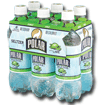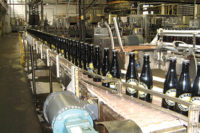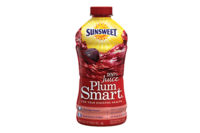
Beverage manufacturers, consumers and retailers all are calling on secondary packaging to be lighter, stronger, greener and cheaper. To keep up with an ever-growing list of demands, secondary packaging manufacturers have prioritized innovation of materials, designs and machinery.
Packaging manufacturers have seen an increased interest in innovation, explains Bill Wagner, director of global marketing for beverage for MeadWestvaco Corp. (MWV), Richmond, Va.
“From our perspective and what we’re hearing from major brand owners, they have spent the last few years driving costs out of their system, not just from a packaging standpoint, but increasing line efficiencies,” Wagner says. “They’ve been focused there and they have kind of realized that their core brands and their core business are not growing … so they are looking at reinvigorating brands and at repositioning brands.”
Saving green
During the recession, consumer behavior has shown that value remains paramount. This year, secondary packaging manufacturers reported increased demand for multipacks and value packs.
Value-focused consumers are creating more opportunities for larger multipacks offered by club stores. Flat-sheet extruded plastic handle manufacturer Roberts PolyPro, Charlotte, N.C., has seen increased demand for single bottle handles and multipack handles for the channel. MWV also is paying attention to club stores, and the paperboard packaging manufacturer is conducting consumer insight research to find out more about consumer priorities and preferences in the channel, Wagner says.
The popularity of club stores has led to more requests from beverage companies for new bulk packaging solutions. Exopack LLC, Hoffman Estates, Ill., recently engineered a shrinkwrap film and carry handle for larger bottles for club stores. Exopack’s packaging solution allowed its customer to enter the club store market with a bundled multipack of larger bottles, explains Mark Pfeiffer, Exopack’s senior national account manager of consumer plastics.
Across all channels, consumers are buying higher count packages of sub-premium or economy brands, says Franck Vidal, senior marketing manager at Graphic Packaging International Inc., Marietta, Ga. The company has worked on 36-packs that use its twin stack method to place one layer of cans on top of another.
Graphic Packaging also offers what Vidal calls “in-between packs,” which are packages with a non-traditional package size or count that can be sold for a target price point, frequently of $3 or $5. The company also is in the development stages for a paperboard can clip for six-packs, Vidal says. This trend toward value is likely to continue as the economic outlook improves, he says.
“When the economy recovers, I can foresee that we will have to deal with thrift-savvy consumers and that value packaging may have to get us to work on bigger packages, such as 40- to 48-count cans and 20- to 24-pack bottles, where consumers can obtain a real discount in the club store channel,” Vidal says.
Retailers also are becoming more involved in the packaging process, Vidal says. Graphic Packaging has seen increasing demand for retailer-exclusive packaging that might emphasize value or image depending on the channel, he says.
Paperboard manufacturer Zumbiel Packaging finds value to be a perpetual issue in the industry, says Charles Mace, vice president of sales and marketing for the Cincinnati-based company.
“I’ve been around so long that it’s always about a price point,” Mace says. “So we continue to say, ‘Let’s do a 20-pack instead of a 24-pack because we can get a better price point,’ or ‘Let’s do an 18-pack or an 8-pack.’ Those tend to come and go, or at least they have during my 20 years in the industry. Everybody is still searching for that magic ounce and price point that’s going to get the stuff to jump. That’s going to continue and will never stop.”
Lighter and sturdier
Consumers are paying more attention to how products fit in with their social responsibilities and priorities, according to a study by Datamonitor, London. More than half of global consumers surveyed reported that protecting the environment is significantly more important to them now than two years ago, and the major way they are showing their concern is paying more attention to packaging, the “Offering Ethicality and Sustainability in Food and Drinks” study found.
The more tangible nature of packaging allows consumers to actually see and feel the difference they are making, said Katrina Diamonon, Datamonitor analyst, in a statement.
“It is clear that although consumers place a great deal of importance on protecting the environment, when it comes to actually changing their behavior, the most common changes are those which require minimal effort or planning,” Diamonon said. “Seeking recyclable and sustainable packaging is a relatively simple measure consumers can take to fight climate change.”
Beverage manufacturers also are trying to minimize secondary packaging to cut costs and reduce overall carbon footprint, while retailers want streamlined secondary shelf-ready packaging that saves time and money in stocking shelves, according to the “2009 Beverage Industry Market Research Study” conducted by the Packaging Machinery Manufacturers Institute Inc., Arlington, Va.
The bottled water industry was an early adopter of sustainable packaging through lightweighted bottles and secondary packages. The PMMI study said an ongoing concern is that the secondary packaging most often used on bottled water was too flimsy and did not provide enough protection to the water bottles.
Exopack adapted its shrinkwrap film to address the lightweighting trend, Pfeiffer says.
“As the gram weight of the PET bottles goes down, the engineering that we put into our films becomes more critical because the bottles themselves aren’t as rigid, and rigid is good,” Pfeiffer says. “The more rigid the container is the less the secondary packages has to do, but with [lightweighted] bottles, particularly in the bottled water industry, our film has to perform at a higher level so we’ve engineered films to assist with that and at the same time still maintain some downgauging opportunity so they have less material across the board.”
Polypack Inc., Pinellas Park, Fla., offers its Nested Pack shrinkwrap solution that uses staggered rows of alternating quantity to produce packs that are sturdy and resist shifting during distribution and consumer handling, says Erik Laracuente, marketing media manager for the company. The package maintains a billboard, but also presents opportunities for shaped shrinkwrap packages, such as a football-shaped package, he says.
Graphic Packaging also offers various solutions with sustainability in mind, including the Easy Pad paperboard replacement for corrugated pads for shrinkwrapped packages. Graphic Packaging also launched a new 12-pack for glass bottles that has reduced fiber weight and includes a glued insert that stabilizes the bottles and reinforces the handle, Vidal says.
Graphic Packaging’s Cap-it paperboard structure for PET bottle multipacks is an alternative to shrinkwrapping multipacks, and offers a billboard that can be stocked various ways, Vidal says. Cap-it paperboard currently is being test marketed by regional soft drink-maker Polar Beverages, Worcester, Mass.
The company also collaborated with Minute Maid, a brand of The Coca-Cola Co., Atlanta, to package its line of beverage pouches into Z-Flute laminated paperboard. The 10-pack replaced corrugate with strategically reinforced Z-Flute paperboard that is light, but retains stacking ability. Z-Flute also reduces the weight of the package, which can deliver cost reduction in supply chain and warehousing costs, Vidal says.
Lightweight and strong also are qualities that Kapstone Charleston Kraft LLC, North Charleston, S.C., promotes in its Kraftpak uncoated carton board. Kraftpak was designed to provide the greatest amount of functionality with the least amount of weight, explains Louie Hancock, market development manager for Kapstone Charleston Kraft. Kraftpak can provide a 20 to 25 percent weight reduction compared to other paperboard substrates and contains 18 percent traceable post-industrial recycled fiber, Hancock says. With a natural brown look, the uncoated paperboard has become a popular choice for craft brewers, he explains.
“Particularly with the smaller brews, the microbrews and the regional brews where some have chosen to project an authentic, strong image to differentiate themselves from the big players, a number of small brands have gone over to the Kraftpak,” Hancock says.
KraftPak is one paperboard option available from NEPA Carton and Carrier Co. Inc., Moosic, Pa. NEPA can custom make a range of sizes and can wraps from four-packs to 30-packs for 10-ounce to 16-ounce bottles, says Julie Fish, corporate account administrator at NEPA. The company offers small minimum runs and has an in-house art department to assist with project design, Fish says.
Another option for multipacks are shrink and stretch sleeves, such as the EZ-Pak system available from PDC Europe Americas Inc., Austin, Texas, and Pennsylvania’s MRI Flexible Packaging. The EZ-Pak system features SleevePak, StackPak and HandyPak no-heat labels, which can be used to create multipacks and easy-to-carry items. In addition, SleeveCo, Dawsonville, Ga., promotes its Combo Pack as a low-cost quick turnaround option for promotions. Combo Packs can be used to group together two or more items of varying sizes for limited time or special offers.
Hartness’ Sustainability Solutions division offers Grab Pack, a retail-ready multipack concept that uses up to 30 percent less film than a traditional bundled package, the Greenville, S.C.-based company says. The Grab Pack is a pre-formed web of printed shrinkable polyethylene film that can be implemented in four-, six-, eight-, 10- and 12-packs that are strong enough to be stacked.
Window of opportunity
The removal of material in the name of sustainability has provided packaging manufacturers with new ways to feature a brand’s primary packaging. MWV has seen the move toward secondary packaging that showcases the primary package, Wagner says.
“Brand owners are spending a lot of time and effort around their primary packaging, whether it’s a bottle design or a can design, and want to ensure that that brand image is translating into secondary packaging,” he says.
Graphic Packaging promotes the improvements of its E-pack line in packaging weight, greenhouse gas and energy consumption compared to existing paperboard packages, Vidal says. The E-pack line contains a reduced fiber quantity and an open corner with added view of the package. Vidal says the package has been launched in South America where consumers prefer to see exactly what they are buying. He suggests see-through packaging might also appeal to the growing segment of Hispanic consumers in the United States.
Zumbiel offers its Z-View multipack with a design that features the primary package, saves material and has a lower cost due material reduction, says Tom Zumbiel III, marketing director for the company. In addition, the company is Forest Stewardship Council and Sustainable Forestry Initiative certified, Zumbiel says.
Zumbiel Packaging has a new launch on the horizon and is adding 200,000-square feet to its current 320,000-square foot facility in Hebron, Ky. The facility opened four years ago and was designed to be energy efficient. The company also buys wind energy and is a member of the U.S. Environmental Protection Agency’s Green Power Partner and Energy Star programs. The expansion is a testament to the company’s versatility, Zumbiel’s Mace says.
“We have the scope and size to handle our major customers, but we also have the flexibility to help the start-up, cutting edge companies with smaller operations,” Mace says.
Advercan, Dallas, incorporated transparency in its Fridge View window packs, which include a transparent panel to show the product inside. Fridge View window packs are available in four-packs and 12-packs that provide space to showcase the product, advertisements or promotions, the company says.
Machine advances
Packaging manufacturers also are designing machines that run lighter packages more efficiently. Polypack introduced the Tango machine, which is a print-registered shrink bundler that uses modular construction to accept several different in-feed modules. Tango’s modular construction allows smaller companies to compete in producing attention-grabbing shrink multipacks for retail sale, Laracuente says.
As market application continues to grow for its injection-molded recyclable HDPE handles, PakTech, Eugene, Ore., introduced an automated machine for application of its six-pack can handles. The automated machine is available in speeds ranging from 200 cans per minute to 2,400 cans per minute, says Amie Thomas, marketing manager for PakTech. The 200-can-per-minute model is a popular option for the craft brewers that are increasingly interested in PakTech’s can toppers, Thomas says.
Roberts PolyPro added a middle tier to its offerings for handle application machinery with a new intermittent motion applicator, says Chris Turner, sales director for the plastics division for Roberts PolyPro. Its air-assisted manual applicators are suited for smaller companies, Turner says. The recently introduced intermittent motion machine can apply two-, four-, six- and eight-pack handles of multiple heights or diameters at rates of 35 to 39 cases per minute. For larger companies, such as a Roberts PolyPro customer that uses 36 million single-bottle handles per year, the high-speed applicator operates at speeds up to 130 bottles per minute.
MWV offers the One Tech 2 technology capability that provides a variety of secondary and tertiary packaging types, counts, various bottles or can shapes on one modular automated system, says Bill Cecil, vice president of innovation for global beverage for MWV. The technology played a part as MWV recently partnered with an international energy drink company for its entrance into the energy shot market, Cecil says.
“We took them from being out of that market to in that market in a very short span of six months, including a brand new line installation,” he says.
One Tech 2 also has the flexibility and changeover to run different packaging options suited for particular markets, such as convenience stores, on-premise locations and mass merchandisers, Wagner says.
MWV also is involved in a long-term project with a North American brewery regarding multipacks for its glass bottles. The project initially took the brewer’s 18-, 20- and 24-packs from pre-printed corrugate into paperboard packaging, Wagner says.
“We’re now working on the second generation of that package to take it out of the pre-printed corrugate and put it into a paperboard package that is less expensive, gives them higher efficiencies in their brewery, removes trucks off the road, removes pallets out of their system,” he says. “Now that we’re taking it to the next step — we are actually reducing the material that much more through redesigning handles and making sure the package is performing at a level where the consumer is interested.” BI
Related Links:
News: New beverage packages feature redesigns, lightweight options
Packaging: Sustainability prevails as the top trend for beverage packaging
Packaging: Rebranding, new packaging and new sizes spark sales

